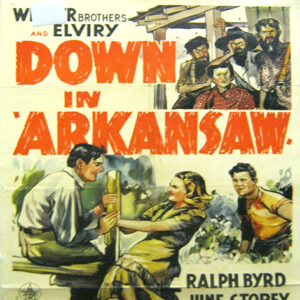calsfoundation@cals.org
Down in "Arkansaw"
B-movie studio Republic Pictures shot hillbilly situation comedy Down in “Arkansaw” (1938) in California. The only Arkansan in the film was Pinky Tomlin, who was born in Eros (Marion County) but raised in Oklahoma.
The film was the first in a series of eleven comedies made by Republic from 1938 to 1943 featuring the Weaver Brothers and Elviry (consisting of Missourians Leon, Frank, and June Weaver), a popular “rube” vaudeville and radio act. The Weaver series also included Arkansas Judge (1941). In his book Hillbilly, Anthony Harkins noted that the years 1937–1945 saw “the hillbilly stereotype at high tide” in popular culture, with the Weavers and Judy Canova making pictures at Republic, Arkansan Bob Burns appearing in films for Paramount (including The Arkansas Traveler, 1938), and the Lum & Abner show on the radio.
Down in “Arkansaw” features government agent John Parker (Ralph Byrd) attempting to persuade the suspicious hill folks of Pine Ridge to sell their land so the government can build a major dam. He makes little progress until he builds a prefabricated demonstration home that shows off the advantages of modern living. The local power company, which will be put out of business by the dam, incites violent resistance, but John and local girl Mary (June Storey) expose their plot. The hill people sell their land, the great dam is built, and John and Mary get married, signifying the union of progressive government and forward-looking rural people.
The very minor, low-budget, barely feature-length (running only sixty-five minutes) film expresses the support many Hollywood filmmakers felt for the New Deal and makes a few superficial points about rural modernization. The film is full of hillbilly stereotypes, including a character (Frank Weaver) who speaks only in bird sounds, though nothing in the film is as extreme and offensive as the figures of gaunt, ragged, bearded, barefoot hillbillies, one asleep with a jug, which form the margins of the film’s lobby cards. A narrator tells viewers that the hill people are unfamiliar with cars, radios, and movies. They greet outsiders with rifles and cries of “Strangers a-comin’!”
The movie also comments on the status of women in the Ozark Mountains. In court, Elviry testifies about her long, arduous workday. A government lawyer compares Elviry, “allegedly thirty-eight,” who looks about fifty, with a city woman, “actually thirty-eight,” who looks years younger than her age. Elviry’s rebellious daughter Mary resists an arranged marriage to a bully and complains, “We women up here are no better than slaves” and “We been kept away from the rest of the world so long, we don’t know what’s goin’ on.” The hill women are much more impressed than the men by the demonstration home with its electric power, running water, telephone, refrigerator, washing machine, vacuum cleaner, toaster, radio, and shower. When the men still hesitate to sell their land, Elviry warns: “We women are gonna have somethin’ to say about this.”
The Variety review (October 12, 1938) called Down in “Arkansaw” “featherweight film fare…for the less particular dualers” (double feature theaters). The reviewer dismissed Nick Grinde’s direction as “slow and unimaginative” and said the Weavers “aren’t half as funny on the screen as they are on the stage.” However, Robert Cochran and Suzanne McCray, in Lights! Camera! Arkansas! (2015), observe that the two Weaver Brothers and Elviry films set in Arkansas—Down in Arkansaw and Arkansas Judge—“mix positive traits of generosity, hospitality, and native intelligence with the standard hillbilly stereotypes.”
For additional information:
Cochran, Robert, and Suzanne McCray. Lights! Camera! Arkansas! From Broncho Billy to Billy Bob Thornton. Fayetteville: University of Arkansas Press, 2015.“
Down in ‘Arkansaw’.” Internet Movie Database. http://www.imdb.com/title/tt0030076/?ref_=fn_al_tt_1 (accessed December 2, 2014).
Harkins, Anthony. Hillbilly: A Cultural History of an American Icon. New York: Oxford University Press, 2004.
Hurst, Richard M. Republic Studios: Between Poverty Row and the Majors. Lanham, MD: Scarecrow Press, 2007.
Williamson, J. W. Hillbillyland: What the Movies Did to the Mountains and What the Mountains Did to the Movies. Chapel Hill: University of North Carolina Press, 1995.
Michael Klossner
Little Rock, Arkansas
 Down in "Arkansaw" Poster
Down in "Arkansaw" Poster 




Comments
No comments on this entry yet.